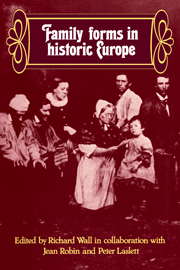Book contents
- Frontmatter
- Contents
- List of contributors
- Preface
- 1 Introduction
- 2 Two kinds of pre-industrial household formation system
- 3 ‘A large family: the peasant's greatest wealth’: serf households in Mishino, Russia, 1814–1858
- 4 The peasant family as an economic unit in the Polish feudal economy of the eighteenth century
- 5 The familial contexts of early childhood in Baltic serf society
- 6 Estonian households in the seventeenth and eighteenth centuries
- 7 Family and familia in early-medieval Bavaria
- 8 The property and kin relationships of retired farmers in northern and central Europe
- 9 Pre-industrial household structure in Hungary
- 10 The reconstruction of the family life course: theoretical problems and empirical results
- 11 The changing household: Austrian household structure from the seventeenth to the early twentieth century
- 12 Does owning real property influence the form of the household? An example from rural West Flanders
- 13 The evolving household: the case of Lampernisse, West Flanders
- 14 The composition of households in a population of 6 men to 10 women: south-east Bruges in 1814
- 15 The importance of women in an urban environment: the example of the Rheims household at the beginning of the Industrial Revolution
- 16 The household: demographic and economic change in England, 1650–1970
- 17 Family and household as work group and kin group: areas of traditional Europe compared
- References
- Index
3 - ‘A large family: the peasant's greatest wealth’: serf households in Mishino, Russia, 1814–1858
Published online by Cambridge University Press: 05 November 2011
- Frontmatter
- Contents
- List of contributors
- Preface
- 1 Introduction
- 2 Two kinds of pre-industrial household formation system
- 3 ‘A large family: the peasant's greatest wealth’: serf households in Mishino, Russia, 1814–1858
- 4 The peasant family as an economic unit in the Polish feudal economy of the eighteenth century
- 5 The familial contexts of early childhood in Baltic serf society
- 6 Estonian households in the seventeenth and eighteenth centuries
- 7 Family and familia in early-medieval Bavaria
- 8 The property and kin relationships of retired farmers in northern and central Europe
- 9 Pre-industrial household structure in Hungary
- 10 The reconstruction of the family life course: theoretical problems and empirical results
- 11 The changing household: Austrian household structure from the seventeenth to the early twentieth century
- 12 Does owning real property influence the form of the household? An example from rural West Flanders
- 13 The evolving household: the case of Lampernisse, West Flanders
- 14 The composition of households in a population of 6 men to 10 women: south-east Bruges in 1814
- 15 The importance of women in an urban environment: the example of the Rheims household at the beginning of the Industrial Revolution
- 16 The household: demographic and economic change in England, 1650–1970
- 17 Family and household as work group and kin group: areas of traditional Europe compared
- References
- Index
Summary
Introduction
‘Nowhere is a large family a greater blessing than among the Russian peasants. Sons always mean additional shares of land for the head of the family … In western Europe a large family is an immense burden and nuisance for the lower classes; in Russia a large family represents the peasant's greatest wealth’ So observed the German political economist August von Haxthausen of the peasantry of the central provinces of European Russia in the 1840s. Publication of the journal of his travels is credited with awakening the interest of educated Russian society in the peasantry, and leaving with Russian intellectuals the suggestion that Russia retained features of the traditional society that had disappeared in western Europe. Haxthausen attributed the large and complex households of central Russia to a unique cultural configuration and a peculiar Russian need for ‘secure family ties’. Frederick Le Play, travelling in the province of Orenburg in 1853, was also struck by the large size and complexity of serf households, which he attributed to the implacable authority of the peasant family patriarch.
These descriptions of the peasant family by two eminent western European observers, while arresting the attention of Russians and non- Russians alike, were not, however, the first to be written. One of the earliest published descriptions of serf peasant households appeared in Russia in 1829. It signalled growing awareness by gentry landlords that to improve rural estates something must be known about their basic units of labour and taxation – the serf family/household.
- Type
- Chapter
- Information
- Family Forms in Historic Europe , pp. 105 - 152Publisher: Cambridge University PressPrint publication year: 1983
- 23
- Cited by



